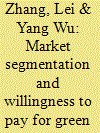|
|
|
Sort Order |
|
|
|
Items / Page
|
|
|
|
|
|
|
| Srl | Item |
| 1 |
ID:
103419


|
|
|
|
|
| Publication |
2011.
|
| Summary/Abstract |
In the United States, nearly 17% of greenhouse gas emissions come from residential energy use. Increases in energy efficiency for the residential sector can generate significant energy savings and emissions reductions. Consumer labels, such as the US Environmental Protection Agency's ENERGY STAR, promote conservation by providing consumers with information on energy usage for household appliances. This study examines how the ENERGY STAR label affects consumer preferences for refrigerators. The results of an online survey of a national sample of adults suggest that consumers are, on average, willing to pay an extra $249.82-$349.30 for a refrigerator that has been awarded the ENERGY STAR label. Furthermore, the results provide evidence that respondent willingness-to-pay was motivated by both private (energy cost savings) and public (environmental) benefits.
|
|
|
|
|
|
|
|
|
|
|
|
|
|
|
|
| 2 |
ID:
171382


|
|
|
|
|
| Summary/Abstract |
Solar energy provides several significant advantages, such as reduced CO2 emissions, more energy supply diversification and regional/national energy independence. Due to the reduced installation cost and the rapid advances in solar energy technology, the installed capacity of solar power has been increasing over time in the United States. Nevertheless, solar energy capacity and policies differ significantly across the US states. Determining the preferences for solar energy policies is critical for future solar energy development. In this study, we used stated preference methods to elicit residents' preferences for solar energy and determine the impact of policies on consumers’ support of solar energy. Results show that US residents have a heterogeneous preferences for different types of solar energy policies. In general, financial support is more effective in promoting solar energy. Compared to most demographics, attitude toward climate change, barriers, and motives for solar energy adoption has a greater impact on preferences for solar energy policies. Moreover, our results confirm the necessity of government subsidies to promote solar energy. The findings could help facilitate the development of solar policy instruments that more effectively encourage the adoption of solar and other sustainable energies.
|
|
|
|
|
|
|
|
|
|
|
|
|
|
|
|
| 3 |
ID:
116968


|
|
|
|
|
| Publication |
2012.
|
| Summary/Abstract |
The objective of this study is to identify market segments and estimate the residents' willingness to pay (WTP) for green electricity (green-e) in China for the large-scale promotion of energy projects from renewable sources that do not rely solely on energy policies. Based on an analysis of non-use values of green-e as well as the application of the contingent valuation (CV) method and payment card (PC) introduction technology, the average WTP ranges from RMB 7.91 yuan/month to 10.30 yuan/month (approximately US$ 1.15-1.51/month with an exchange rate of 6.83 yuan/US$ yuan/US$) for urban residents in Jiangsu Province. The current work also explores the differences in demographic variables across varying WTP amounts and the different marginal effects of demographic variables at the same level of WTP. The findings reveal that there are significant differences in demographic variables, such as level of education, household income and location of residence, across the population segments. Moreover, the finding that some respondents with high income and higher education prefer higher WTP amounts to lower WTP amounts suggests that green-e is a luxury product, and consequently, a Veblen effect exists in certain Chinese market segments.
|
|
|
|
|
|
|
|
|
|
|
|
|
|
|
|
| 4 |
ID:
094956


|
|
|
|
|
| Publication |
2010.
|
| Summary/Abstract |
In order to overcome the perverse incentives of excessive maintenance reductions and insufficient network investments arising with incentive regulation of electricity distribution companies, regulators throughout Europe have started regulating service quality. In this paper, we explore the impact of incorporating customers' willingness-to-pay for service quality in benchmarking models on cost efficiency of distribution networks. Therefore, we examine the case of Norway, which features this approach to service quality regulation. We use the data envelopment analysis technique to analyse the effectiveness of such regulatory instruments. Moreover, we discuss the extent to which this indirect regulatory instrument motivates a socially desired service quality level. The results indicate that internalising external or social cost of service quality does not seem to have played an important role in improving cost efficiency in Norwegian distribution utilities.
|
|
|
|
|
|
|
|
|
|
|
|
|
|
|
|
| 5 |
ID:
119835


|
|
|
|
|
| Publication |
2013.
|
| Summary/Abstract |
This paper provides the first willingness-to-pay (WTP) estimates in support of a national climate-change policy that are comparable with the costs of actual legislative efforts in the U.S. Congress. Based on a survey of 2034 American adults, we find that households are, on average, willing to pay between $79 and $89 per year in support of reducing domestic greenhouse-gas (GHG) emissions 17% by 2020. Even very conservative estimates yield an average WTP at or above $60 per year. Taking advantage of randomized treatments within the survey valuation question, we find that mean WTP does not vary substantially among the policy instruments of a cap-and-trade program, a carbon tax, or a GHG regulation. But there are differences in the sociodemographic characteristics of those willing to pay across policy instruments. Greater education always increases WTP. Older individuals have a lower WTP for a carbon tax and a GHG regulation, while greater household income increases WTP for these same two policy instruments. Republicans, along with those indicating no political party affiliation, have a significantly lower WTP regardless of the policy instrument. But many of these differences are no longer evident after controlling for respondent opinions about whether global warming is actually happening.
|
|
|
|
|
|
|
|
|
|
|
|
|
|
|
|
|
|
|
|
|